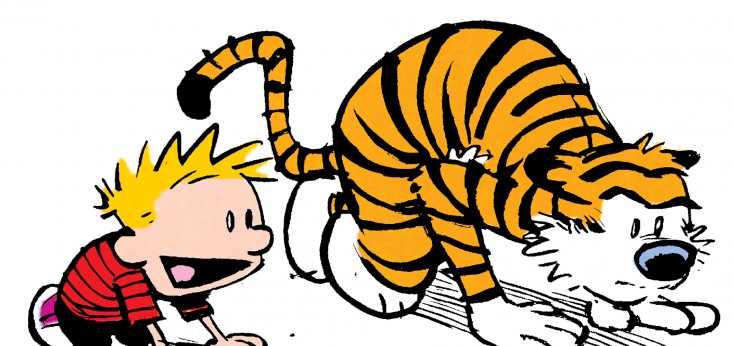By ANGELA DAWSON
Front Row Features
HOLLYWOOD—Calvin & Hobbes, a comic strip featuring an adventuresome and imaginative boy and his beloved toy tiger, began appearing in newspapers in 1985, and quickly became one of the most popular strips of all time. It ran only 10 years before its creator, the enigmatic and talented Bill Watterson, decided to retire it, leaving millions of fans wanting more and yet joyful that at least they had that glorious decade to go along on the boy and his pal’s journey every day on the comics page.
Among Calvin & Hobbes fans is Joel Allen Schroeder, a 34-year-old filmmaker who has made a documentary “Dear Mr. Watterson” as an homage to the comic strip that has had such an impact on its readers and to discover why the work maintains its popularity today. In the film, he speaks with fans, Watterson’s contemporaries, his editor and others about the enduring popularity of Calvin & Hobbes, despite the fact (or maybe because) Watterson refused to license his product for commercial purposes.
A Wisconsin native who attended the University of Wisconsin and graduated from USC’s film production program, Schroeder spoke about what sparked his interest in Calvin & Hobbes, and why he chose not to pursue the reclusive Watterson for his film and instead chose to focus on the impact of his work. Having started the project in 2007, he was one of the first users of the Kickstarter crowdfunding platform. The film has finally been theatrically released after making the rounds at several film festivals around the country.
Q: How did this documentary come about?
Schroeder: Clearly I am a fan. I loved the strip as a kid. I was in my late 20s when the idea came about. I don’t know if I had been re-reading the strip at the time. Calvin & Hobbes has stuck with me and means a lot to me. As an adult, not everything from your childhood maintains significance. I’d been out of film school for several years and ideas for projects had come and gone. I’d worked a lot on other people’s projects. It’s a lot more satisfying to work on your own projects than other projects you don’t have the passion for. When the idea came about, it stuck with me and I felt compelled to move forward on it. It’s something I’ve been working on for 6-1/2 years or so. It’s a passion project. I was surprised no one had done something like this before. I felt compelled to do it. I didn’t have all the resources I needed right away but at least the determination to move forward and make it happen.
Q: You explain in the documentary that you purposely decided not to try and interview Mr. Watterson out of respect for his privacy. But did you kind of wish he would have emailed you or contacted you in some way?
Schroeder: Sure, you fantasize about what may happen. I’d like to think there are ways he is included in the film. You don’t see him necessarily, but he’s there in the art and other ways we brought his voice into the film. I didn’t want it to be one of those films where it’s looking for him. I didn’t want that story to take over. Because I think once you put out that request for an interview and then get turned down, you’re then you’re asked the question, “Did you ask him for an interview,” and then I have to say “Yes, I did,” and that becomes the story. Then it becomes about how much of a recluse he is. Instead, I wanted the story to be about the impact of the strip and how ink and paper and the creativity of one man can have such meaning to people years and years after the strip has disappeared from newspapers.
Q: You have some interesting motion graphics in the film. How did that come about?
Schroeder: The visual effects and graphics artist is Mike Dillinger. He’s a Los Angeles motion graphics artist. He was one of our Kickstarter backers. When we did our second Kickstarter campaign, which really enabled us to do that kind of thing. It wasn’t until we did our second Kickstarter campaign that we could afford to spend money on an original score and focus on motion graphics. It definitely took it up another notch and we love the work that Mike did.
Q: You include actor Seth Green talking about his love of Calvin & Hobbes. Why him?
Schroeder: We talked to Seth because he had done a parody of “Calvin & Hobbes” on his show “Robot Chicken.” He seemed like a natural fit. He was willing to come talk. It was a short interview but he had really good things to say. There were some people that were difficult to get and some took a little bit of time to persuade to do it. Others were ready to talk right away. We were happy to have all of them involved.
Q: Universal Press Syndicate’s Lee Salem, Watterson’s editor, could have licensed “Calvin & Hobbes” for dolls and other products but he respected Bill Watterson’s wishes. Did he say anything about why he did that?
Schroeder: Ultimately, there’s probably plenty of things about that “battle” with the syndicate that the public may never know but Lee saw that this (noncommercialization of Calvin & Hobbes was) of utmost importance to Watterson. He respected him and knew he had a great talent on his hands. They had the legal right to merchandise, but he knew that if he pushed too hard and pursued those things, Lee knew it wasn’t going to end well. He knew that would have brought upon the end of Watterson’s involvement, and instead of seeing 10 years of “Calvin & Hobbes,” we would only have seen five or six years. Luckily, he did decide to renegotiate the contract and it worked out for the best.
Q: Your film starts out as a homage by fans to the comic strip and the it becomes a study of what’s happening with comic strips with the demise and shrinking of newspapers across the country. Do you see comic strips as a dying art?
Schroeder: We spoke with Jenny Robb about this. She the curator of the Billy Ireland Cartoon Library and Museum at Ohio State University. I can’t remember what she said exactly but the gist of it was comics and cartoons will continue in some fashion. They may be different the way we ingest them or the way they’re produced. They may be very different 100 years from now but she’s confident they will exist. The way I learned to love the comics is definitely dying. I remember grabbing the paper and laying on the carpet in front of the big bay window at our house, and the comics page was huge, and now I was recently in a coffee shop and looking at the comics section, and the width of it was barely larger than a notepad. That’s definitely changing and going away. It’s been shrinking for decades. Luckily, I think there is a lot of talent out there, but the cartoonists that are coming up may find it harder to be successful. It may be something they may not be able to put their talents to full time but there are a lot of things out there. It’s evolving and will continue to evolve.
Q: You’re one of the early users of Kickstarter crowdfunding platform and successful in getting contributors involved with this. Can you talk about raising the money for this?
Schroeder: We were pretty early on in the life of Kickstarter. We did two campaigns. The first one we launched even before they had office space. When we learned about them, we found it was a perfect fit for this project. Up until that point, the project was moving rather slowly because the only money we had was whatever I could afford to spend on it at the time. The first goal was $12,000. I look back now and see how naïve I was. But this wouldn’t have gotten made without naivete. But we were lucky because there are so many people out there that love Calvin & Hobbes so when they heard about me making this documentary they wanted to help me make it happen. By the end of it, we raised about twice our goal and that kept us going for another couple years. That covered most of production and really did kickstart the project. When we had 350 or so backers that were part of the team, the scope changed and expanded. It made the project better—having all these people who wanted it to succeed.
Q: Did any of your contributors end up on the film?
Schroeder: There are a few scattered in there. I couldn’t tell you a number offhand. Four to five, maybe. There are people where there are interviews or a photo of someone, but yes, there are people who contributed to the project and are in there in some small form. There are also people who are the reverse. We talked to them and they’re in the film and later on backed us up on Kickstarter.
Q: Are you working on another film now?
Schroeder: There are a few ideas I’m pursuing. This project has been all consuming for me. Once it’s out there in the world, then I feel I can move on. We’ll see what ideas come up that I’m as passionate about as “Dear Mr. Watterson.”
Q: Are your kids fans of Calvin & Hobbes?
Schroeder: No kids yet. Just greyhounds. I have a niece and I’ve already started to put Calvin & Hobbes in front of her. When she was a year old and I was babysitting her and I made sure to stick a book in front of her a little bit.
The entire Calvin and Hobbes collection is available free on the GoComics website and mobile app.
Website: http://www.GoComics.com/CalvinAndHobbes






